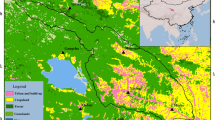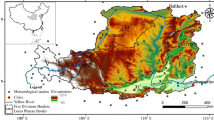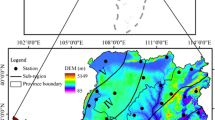Abstract
This study focused on the changes of reference evapotranspiration (ET0) and pan evaporation (ETpan) to study the impacts of climate change on the hydrological cycle in the Jinghe River catchment. Based on the Penman–Monteith equation, the ET0 was calculated. The temporal trend and spatial distribution of ET0 and Epan measured with a 20-cm pan were examined at the 14 stations during 1957–2005. The effects of meteorological factors on the variation of ET0 were determined by analyzing the trends in themselves with comparison between original climate and detrended climate scenarios and then their sensitivity to ET0. Both the ET0 and Epan showed remarkable decreasing trends from 1957 to 2005 and their decreasing rate was 40.9 and 17.7 mm per 10 years, respectively. Trend analysis of meteorological factors exhibited that the reduction in ET0 and ETpan was principally caused by both significant decreases in wind speed and sunshine hours. Furthermore, the decreasing trend of ET0 was mainly dominated by the significant decrease in wind speed with high sensitivity, to a less extent, by the decrease in net radiation. Although relative humidity is one of the most sensitive variables, its effect on ET0 was negligible because of its temporal constancy. The contribution of wind speed reduction to decreased ET0 has increased from 50 to 76.1%, but net radiation, by contrast, decreased from 50 to 23.9%.







Similar content being viewed by others
Abbreviations
- ET0 :
-
Reference evapotranspiration
- E pan :
-
Pan evaporation
- DTR:
-
Diurnal temperature range
- SA:
-
Sensitivity analysis
- e a :
-
Actual vapor pressure
- e s :
-
Saturated vapor pressure
- DFA:
-
Detrended fluctuation analysis
- VPD:
-
Vapor pressure deficit
- T max :
-
Average annual maximum temperature
- R n :
-
Net solar radiation
- T min :
-
Average annual minimum temperature
- FAO:
-
Food and Agricultural Organization
References
Abakumova GM et al (1996) Evaluation of long-term changes in radiation, cloudiness, and surface temperature on the territory of the former Soviet Union. J Clim 9:1319–1327
Allen RG, Pereira LS, Raes D, Smith M (1998) Crop evapotranspiration. Guidelines for computing crop water requirements. FAO Irrigation and drainage paper 56, Rome
Bunde A, Havlin S, Kantelhardt JW, Penzel T, Peter JH, Voigt K (2000) Correlated & uncorrelated regions in heart-rate fluctuations during sleep. Phys Rev Lett 85(17):3736–3739
Burn DH, Hesch NM (2007) Trends in evaporation for the Canadian prairies. J Hydrol 336(1–2):61–73
Chattopadhyay N, Hulme M (1997) Evaporation and potential evapotranspiration in India under conditions of recent and future climate change. Agric For Meteorol 87:55–73
Chen R, Ersi K, Yang J, Lu S, Zhao W (2004) Validation of five global radiation models with measured daily data in China. Energy Convers Manage 45(11–12):1759–1769
Dai A, Tenberth KE, Karl TR (1999) Effects of clouds, soil moisture, precipitation and water vapor on diurnal temperature range. J Clim 12:2451–2473
Golubev VS et al (2001) Evaporation changes over the contiguous United States and the former USSR: a reassessment. Geophys Res Lett 28:2665–2668
Gong L, Xu C, Chen D, Halldin S, Chen Y (2006) Sensitivity of the Penman-Monteith reference evapotranspiration to key climatic variables in the Changjiang (Yangtze River) basin. J Hydrol 329(3–4):620–629
Harbeck E (1962) A practical and field technique for measuring reservoir evaporation utilizing mass-transfer theory. Geol Surv Prof Pap Wash 272(E):100–105
Helsel D, Hirsch R (1993) Statistical methods in water resources. Elsevier, Amsterdam
Hobbins MT, Ramirez JA, Brown TC (2004) Trends in pan evaporation and actual evapotranspiration across the conterminous U.S.: paradoxical or complementary? Geophys Res Lett 31:L13503. doi:10/10029/2004GL019846
Kaiser DP, Qian Y (2002) Decreasing trends in sunshine duration over China for 1954–1998: indication of increased haze pollution? Geophys Res Lett 29(21):2042
Kantelhardt J, Koscielny-Bunde E, Rego H, Havlin S, Bunde A (2001) Detecting long-range correlations with detrended fluctuation analysis. Phys A Stat Mech Appl 295(3–4):441–454
Kendall M (1975) Rank correlation measures. Charles Griffin, London
Koscielny-Bunde E, Kantelhardt J, Braun P, Bound A, Havlin S (2006) Long-term persistence and multifractality of river runoff records: detrended fluctuation studies. J Hydrol 322(1–4):120–137
Liepert BG (2002) Observed reductions of surface solar radiation at sites in the United States, worldwide from 1961 to 1990. Geophys Res Lett 29:1421. doi:10.1029/2002GL014910
Liepert BG, Feichter J, Lohmann U, Roeckner E (2004) Canaerosols spin down the water cycle in a warmer and moister world? Geophys Res Lett 31:L06207. doi:10.1029/2003GL019060
Liu CM, Zeng Y (2004) Changes of pan evaporation in the recent 40 years in the Yellow River basin. Water Int 29(4):510–516
Liu Q, Yang ZF, Cui BS, Sun T (2010) The temporal trends of reference evapotranspiration and its sensitivity to key meteorological variables in the Yellow River Basin, China. Hydrol Process 24(15):2171–2181
Mann H (1945) Nonparametric tests against trend. Econometrica 13(3):245–259
Paturel J, Servat E, Vassiliadis A (1995) Sensitivity of conceptual rainfall-runoff algorithms to errors in input data—case of the GR2 M model. J Hydrol 168(1–4):111–125
Peterson TC, Golubev VS, Groisman PY (1995) Evaporation losing its strength. Nature 377:687–688
Prescott JA (1940) Evaporation from a water surface in relation to solar radiation. T Roy Soc South Aust 64:114–125
Qian T et al (2006) Simulation of global land surface conditions from 1948–2004. Pt I: forcing data and evaluations. J Hydrometeorol 7:953–975
Qiu GY, Yano T, Momii K (1998) An improved methodology to measure evaporation from bare soil based on comparison of surface temperature with a dry soil surface. J Hydrol 210(1–4):93–105
Qiu GY, Yin J, Xiong YJ, Zhao SH, Wang P (2008) Studies on the effects of climatic warming-drying trend and land use change on the runoff in the Jinghe River basin. J Nat Res 23(2):211–218 (In Chinese)
Roderick ML, Farquhar GD (2004) Changes in Australian pan evaporation from 1970–2002. Int J Climatol 24:1077–1090
Roderick ML, Farquhar GD (2005) Changes in New Zealand pan evaporation since the 1970s. Int J Climatol 25:2031–2039
Saltelli A, Ratto M (2008) Global sensitivity analysis: the primer. Wiley, New York
Shenbin C, Yunfeng L, Thomas A (2006) Climatic change on the Tibetan Plateau: potential evapotranspiration trends from 1961–2000. Clim Change 76(3):291–319
Sumner DM, Jacobs JM (2005) Utility of Penman–Monteith, Priestley–Taylor, reference evapotranspiration, and pan evaporation methods to estimate pasture evapotranspiration. J Hydrol 308(1–4):81–104
Tebakari T, Yoshitani J, Suvanpimol C (2005) Time-space trend analysis in pan evaporation over Kingdom of Thailand. J Hydrol Eng 10:205–216
Thornthwaite C (1948) An approach toward a rational classification of climate: the geographical review. New York 38:55–94
Turc L (1961) Estimation des besoins en eau d’irrigation, evapotranspiration potentielle, formule climatique simplifiee etmise a jour. Ann Agron 12(1):13–49
Xu CY, Singh VP (2000) Evaluation and generalization of radiation-based methods for calculating evaporation. Hydrol Process 14(2):339–349
Xu CY, Singh VP (2001) Evaluation and generalization of temperature-based methods for calculating evaporation. Hydrol Process 15(2):305–319
Xu CY, Vandewiele G (1994) Sensitivity of monthly rainfall-runoff models to input errors and data lengths. Hydrol Sci J 39(2):157–176
Xu CY, Gong LB, Jiang T, Chen DL, Singh VP (2006) Analysis of spatial distribution and temporal trend of reference evapotranspiration and pan evaporation in Changjiang (Yangtze River) catchment. J Hydrol 327(1–2):81–93
Xu ZX, Zhao F (2005) Variation of sunlight radiation duration in the Yellow River Basin. Resour Sci 27(5):153–160 (in Chinese)
Yin Y, Wu S, Chen G, Dai E (2009) Attribution analyses of potential evapotranspiration changes in China since the 1960s. Theor App Climatol 101(1–2):19–28
Acknowledgments
We acknowledge, with gratitude, the financial support from the National Natural Science Foundation of China (30972421) and the National Basic Research Program of China (2009CB421308). We also the Professor D. Y. Gong (Beijing Normal University) for his valuable advice and to China Meteorological Administration for providing meteorological data.
Author information
Authors and Affiliations
Corresponding author
Rights and permissions
About this article
Cite this article
Wang, P., Yamanaka, T. & Qiu, G.Y. Causes of decreased reference evapotranspiration and pan evaporation in the Jinghe River catchment, northern China. Environmentalist 32, 1–10 (2012). https://doi.org/10.1007/s10669-011-9359-0
Published:
Issue Date:
DOI: https://doi.org/10.1007/s10669-011-9359-0




